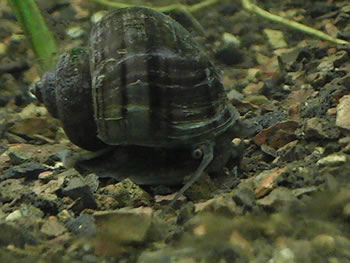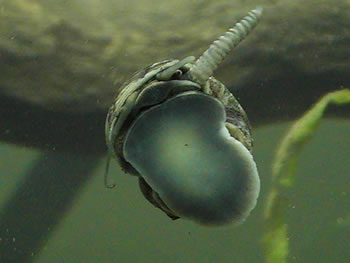Black Mystery Snail

Black Mystery snail - Picture by jeffandkittie

Black Mystery snail - Picture by jeffandkittie
The Black Mystery Snail belongs to the genus Pomacea in the family Ampullariidae. This family is also called the Apple Snail family and comprises around 120 different snail species. Earlier, this family used to be referred to as Pilidae. Like all the other members of the genus Pomacea, the Black Mystery Snail is equipped with a siphon. This siphon makes it possible for the Black Mystery Snail to breathe air from the atmosphere while still submerged in water, since the siphon can be extended above the water's surface. In the genus Pilidae, it is common for the siphon to be longer than the entire length of the snail's body. The coloration of the Black Mystery Snail can of course be black, but patterns and colors vary a great deal between each snail and can for instance include gold and ivory as well.
Carrying for a Black Mystery Snail is easy and you can comfortably house one even if your aquarium is no larger than 10 gallons. When the Black Mystery Snail is offered in pet shops, it is usually around 3/4" to 1-1/4". It can grow up to 2" long in captivity. It is a peaceful creature which makes it a good addition to most community aquariums. Before you purchase a Black Mystery Snail, you should make sure that none of your fish species will view the snail as food.
The Black Mystery Snail will tolerate quite a broad pH range and will do well as long as the pH is kept between 6.5 and 8.0. The KH should be in the 12-18 range and the water temperature from 68 to 85° F. As mentioned above, the Black Mystery Snail needs to breath oxygen from the air and will drown if prevented from this. You should therefore leave at least 2 inches of open air space between the water's surface and any aquarium lid.
The Black Mystery Snail originates from Brazil where it usually stays passive during the day and begins its search for food as the sun sets. It will usually search for food in the water, but can also leave the water and look for food on land. In your aquarium, you will typically find it crawling up the glass or searching for food in the substrate. It is an omnivore species that will function as a scavenger in your aquarium and remove left over fish food, plant matter, algae etcetera. You can feed it most types of fish food, including flake food, frozen food and live food. It will also like to have vegetables and/or algae in its diet, especially if the aquarium is unplanted.
Just like the other members of the Ampullariidae family, the Black Mystery Snail is either male or female. It can be very hard to distinguish males from females. If you keep two Black Mystery Snails of similar age together under the same conditions, and feed them the same food, the female will be the largest one of the two. When Black Mystery Snails reproduce, the deposit clutches of eggs right above the waterline. The female will typically lay from 200 to 600 eggs, and she usually deposit them during the night when it is dark. The temperature will determine how long you have to wait before the eggs hatch, but if you keep the snails in their normal water temperature it will take between two and three weeks. The offspring will eat the same food as the adult Black Mystery Snails, only smaller bits.
Didn't find the info you were looking for? Register for free and ask your question in our Aquarium forum !
Our knowledgeable staff usually responds to any question within 24 hours
Related Articles
Amano shrimp- Information about Amano shrimp
Amano Algae Eating Shrimp - An article about the algae eating Amano shrimp
Apple snail - An introduction to apple snails.
Aquarium crabs - A guide to aquarium crabs
Breeding Crayfish - basics too crayfish breeding
Breeding of Red Clawed Mangrove Crabs - How to breed red clawed crabs
Freshwater shrimp - Information about Freshwater shrimp
Ghost shrimp - Information about Ghost shrimp
Malaysian Rainbow Shrimp - Information on how to keep and breed this shrimp species.
Red Cherry Shrimp - A guide to this Algae eating shrimp.
Red clawed lobsters - A short overview of red claw lobsters (crayfish)
Red Nosed Shrimp - information on keeping this shrimp in aquarium.
Snails: Friend or Foe in the Aquarium? - The biology of snails. Their advantages and disadvantages in an aquarium. How to keep them in check.
